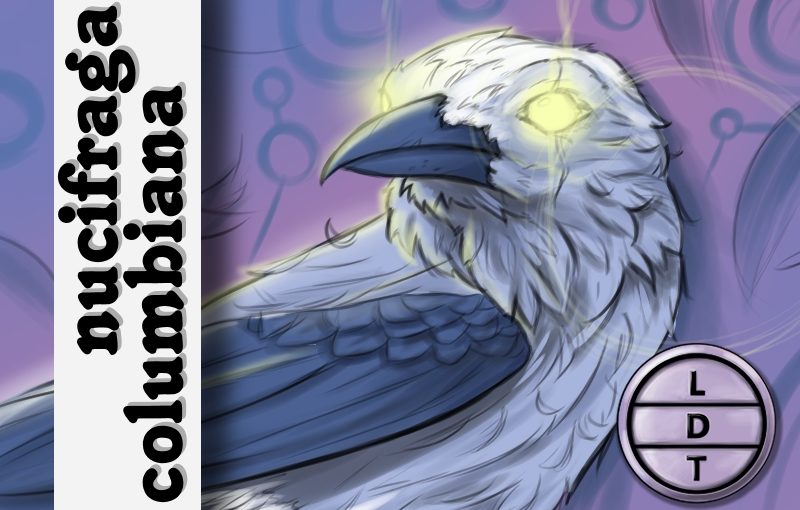“Today we’re talking about a bird with a knack to crack snacks and packs snacks to prep for when Jack frost comes back. But more on that later.”
You may know that a lot of nature’s most amazing animal adaptations are developed in the bitter fight against winter. When earth tilts away from the warmth of the sun towards the chill of space, animals have to be prepared. When there’s no food to be found for months at a time, you’ve got to stock up. But one bird braves the cold with a 100 acre pantry. But preparation may be a matter of life, death, and taxonomy.
Measure Up
Length: 10.6-11.8 in (27-30 cm) – 11 inches – How many Clark’s Nutcrackers go into the hight of the world’s tallest nutcracker in Roseburg, OR (41 feet)? Hint: The Oregon Nutcracker, does not hold the world record because it is not fully functionally. The largest functional nutcracker is 10.10 m (33 ft 1 in) and it’s in Neuhausen, Germany. Answer: 44.7 birds.
Weight: 3.7-5.7 oz (106-161 g) – 4 oz – How many nutcrackers go into a teaspoon… of neutron star material? Hint: A neutron star is about 1.4 times the mass of the sun but it’s only about 18 miles across. To escape the gravitational pull of a neutron star, you’d have to go 0.4 times the speed of light. Answer: 80 billion
Major Fact
- The Clark’s Nutcrackers primary food source is the best part of a fancy salad, aka pine seeds.
- The bird lives in colder regions, and like ever northern north american animal, it has to prepare for the winter.
- To prepare, Clark scours pine forests, picking pine seeds out of their cones.
- They use their slender beaks to reach into cones and pluck the seeds out.
- They will eat a few and hide the rest.
- They will hide literally thousands of nuts in the ground and inside the holes in tree trunks.
- In fact, it’s estimated that each bird hides around 100,000 seeds every year.
- Each cache can hole between one and 15, usually about four or five.
- They return to the caches throughout the winter to feed.
- But how do they remember and find all of the thousands of seeds they bury?
- They don’t, they leave many behind which often sprout new seedlings.
Here’s where the fact get’s major…
- Clark is the key distributor for many species of pine tree.
- One tree, the white bar pine, is Clark’s favorite food source.
- And the bird is that pine’s primary seed distributor.
- The white bark pine cone doesn’t open on it’s own.
- The most efficient way to open a whitebark pine cone is with Clark’s nutcracker beak.
- Tree and the bird depend on each other so much, they have developed something called mutualism, which is a type of symbiosis that benefits both organisms.
- In this case, tree keeps it’s cone closed so that other animals don’t clean it out.
- The bird essentially has a key to this treasure trove that most other animals can’t get to.
- In recent years, a population explosion pine beetles have killed a lot of whitebark pines, which may threaten the bird.
- Researchers have been studying this phenomenon.
- If you’d like to learn more about this bird and this tree, there will be a link on the Clark’s Nutcracker page on ldtaxonomy.com.
- Of a a Cornell researcher named Taza Schaming that believes that the Clark’s nutcracker may be to bringing the trees back.
Outro
We may be a week late talking about nutcrackers, but it’s never to late for interesting animal info and it’s not too late to give your ole’ pals at LDT a lil belated Christmas gift in the form of an itunes review! We also want to thank recent listeners, like Josiah, who have sent in some animal suggestions. Suggestions really help to pad out our schedule and let’s us know what you would want to learn about! Connect with us on Twitter, Facebook, Instagram, or Gmail. We are ldtaxonomy on all of those platforms. As always, thanks for listening and engaging!

